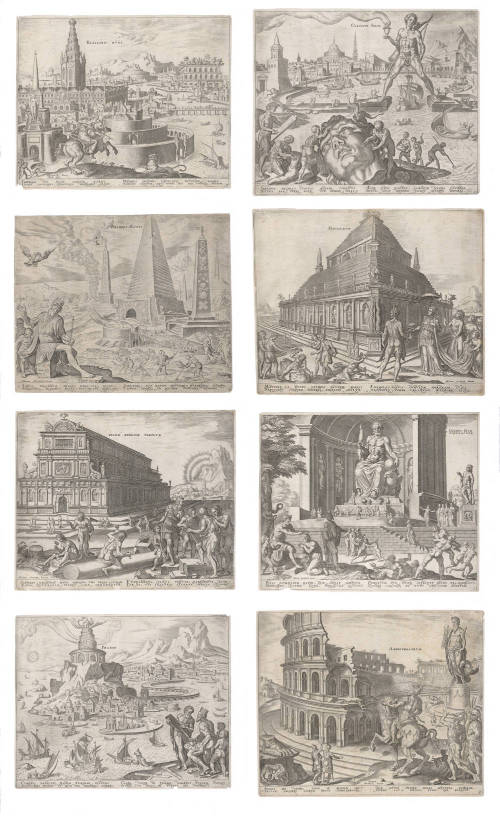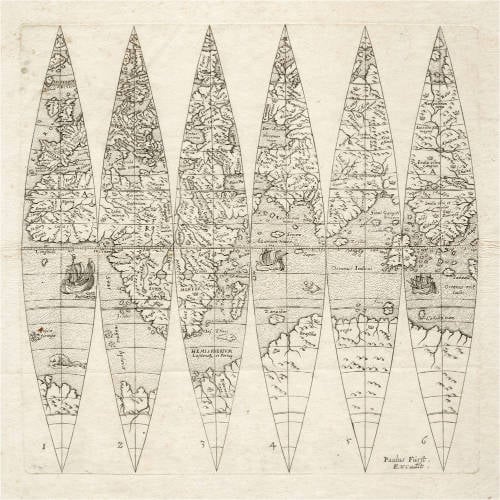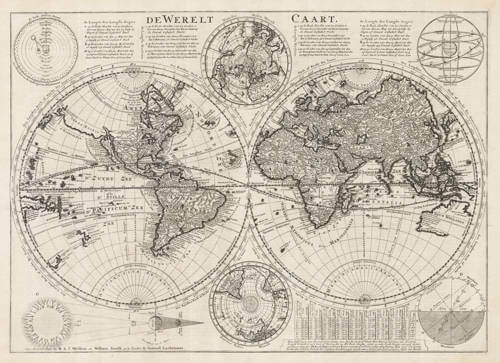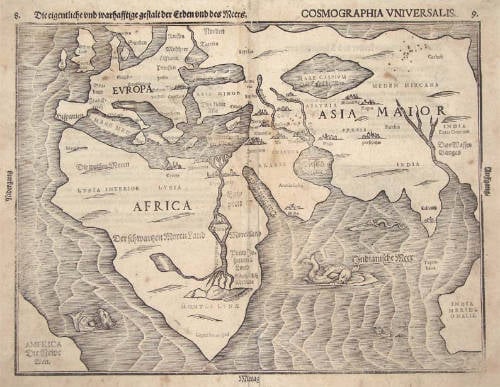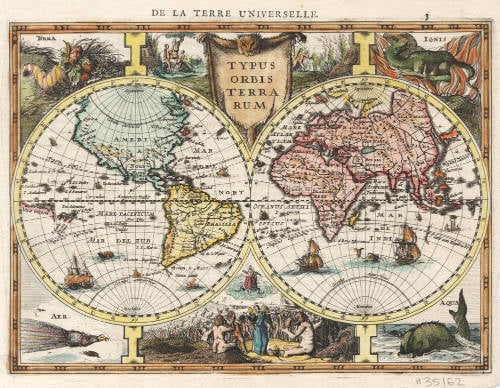Leen Helmink Antique Maps
Allegories of the seven wonders of the world by Maarten van Heemskerck
Stock number: 19101
Zoom ImageCartographer(s)
Maarten van Heemskerck (biography)
Title
[ The Seven Wonders of the World and the Ruins of the Coliseum ]
First Published
Antwerp, 1572
This Edition
Antwerp, first states of 1572
Size
21.3 x 26.2 cms
Technique
Condition
excellent
Price
$ 17,500.00
(Convert price to other currencies)
Description
A complete and homogeneous set of the Wonders of the World, all in first state, engraved by Philips Galle in 1572, after designs by Maarten van Heemskerck. Eight engravings were part of this series. Celebrated monuments that were labeled as Wonders of the World have been known since antiquity.
For a detailed treatment of each of the wonders, and Maarten van Heemskerck's versions of them, see Wonders of the World.
Summary
Legendary and iconic engravings by Philip Galle of the seven wonders of the ancient world, after drawings by Maarten van Heemskerck. Van Heemskerck added the Colosseum in Rome as the eight wonder.
Monumenta Cartographica Neerlandica Volume VI, Map 1
Willem Jansz [Blaeu] 1606 map of the World on Mercator's projection
Blaeu's 1606 world map is framed on all sides by decorative borders. The top border consists of the SEPTEM PLANETA with illustrations of the planet gods of classical mythology in seven oval medallions: the moon goddess LUNA as the goddess of the hunt; MERCURIUS as the god of trade; VENUS as the goddess of love; the sun god SOL; MARS as the god of war; the King of gods IUPITER, with his thunderbolts; and SATURNUS as the god of growth.
These seven figures of gods are counterbalanced by the lower border in the SEPTEM MIRABILIA MUNDI where seven medallions contain depictions of the Seven Wonders of the Ancient World:
MURUS BABYLONIÆ, the wall of Babylon;
COLOSSUS, the gigantic statue above the harbour entrance of Rhodes;
PYRAMIDES, the Egyptian pyramids;
MAUSOLEUM, the tomb of King Mausolos in Halicarnassus;
DIANÆ TEMPLUM, the Temple of Artemis at Ephesus;
IUPITER OLYMPICUS, the statue of Zeus of Phidias at Olympia; and
PHAROS, the lighthouse of Alexandria.
The side borders are divided into four rectangular segments, with the four elements (QUATUOR ELEMENTA) on the left and the four seasons (QUATUOR ANNI TEMPESTATES) on the right.
The decorative borders of the world map were not derived from artists' designs specially ordered by the publisher. On the contrary, Blaeu had a compilation made from various series of prints which had already been published by famous Dutch artists at the end of the sixteenth century. A balanced composition and elegant ornamentation make this world map one of the small masterpieces of the seventeenth century.
(Gunter Schilder)
Monumenta Cartographica Neerlandica Volume IV
Map of the World in folio size, drawn on Mercator's projection, 1606
In the lower border are the Seven Wonders of the Ancient World as counterparts of the seven gods representing the planets. A series of prints also served as a model for them, namely, seven of the eight 1572 engravings by Filips Galle after Maarten van Heemskerck. Van Heemskerck (1498-1574) confined himself in particular to issuing very accurate, detailed sketches, which were then engraved in copper by various able engravers, such as Dirck Volkertsz Coornhert, Filips Galle, Herman Jansz Muller, Cornelis Cort. Inspired by Italian humanism from the sixties on, Van Heemskerck began to emphasize instructional subjects with, for example, an informative series on the seven planets, the four seasons, the four temperaments, the wonders of the world, and illustrations from history. In carrying out these projects, he benefited from a collaboration with the humanist Hadrianus Junius (1511-1575), who provided numerous prints with Latin explanations in verse.
The rediscovery of ancient writers such as Herodotus, Plinius, and Strabo brought the wonders of the world to people's notice again. Van Heemskerck is credited with being the first to make a series of sketches of all Seven Wonders of the World. In this series the artist still added the Colosseum in Rome as the eighth wonder of the world. The sketches of the colossus of Rhodes, the temple of Diana in Ephesus, the walls of Babel, the lighthouse of Alexandria and the Colosseum in Rome have been preserved (Courtauld Institute, London).
Two years later these drawings, made in 1570, were engraved in copper by Filips Galle, and served as models for the engraver of Blaeu's map of the world.
(Gunter Schilder)
Rarity
Complete homogeneous sets are of highest rarity. Very few complete sets have come to the market in modern times. Lacking in nearly every collection.
Condition description
First states with the publishers address of Philips Galle, before that of Theodor Galle in state II and III. A complete homogeneous set in mostly excellent, even impressions of the first state, trimmed to the plate mark, usually with tread margins around it. Occasional small defect to the corners or small repaired defect along the invisible flattened vertical middle fold.
Maarten van Heemskerck (1498-1574)
Maarten van Heemskerck (1498–1574), born Maarten Jacobsz in Heemskerk, North Holland, was one of the most prominent Flemish artists of the 16th century, renowned for his innovative paintings, altarpieces, and engravings that bridged Netherlandish traditions with the influence of Italian Renaissance art. His prolific career, marked by technical mastery and a keen interest in classical antiquity, produced a diverse body of work, including his iconic series of engravings depicting the Seven Wonders of the Ancient World. Van Heemskerck’s contributions to Northern Renaissance art, particularly through his integration of Italianate styles and his focus on historical and mythological subjects, established him as a pivotal figure in the cultural landscape of the Low Countries.
Born in 1498 to a farmer, Jacob Willemsz van Veen, Van Heemskerck initially trained under Cornelis Willemsz in Haarlem before apprenticing with the renowned painter Jan Lucasz in Delft around 1527. His early exposure to the works of Jan van Scorel, a leading Dutch artist who had studied in Italy, profoundly shaped his artistic trajectory. In 1532, Van Heemskerck embarked on a transformative journey to Italy, spending four years in Rome and other cities. There, he immersed himself in the study of classical antiquities, Renaissance masters like Michelangelo and Raphael, and architectural marvels such as the Colosseum. His meticulous sketches of Roman ruins, sculptures, and contemporary artworks, including studies of Michelangelo’s Last Judgment, informed his later compositions and fueled his fascination with the grandeur of the ancient world.
Upon returning to Haarlem in 1536, Van Heemskerck joined the Haarlem Guild of St. Luke and established himself as a leading artist. His paintings from this period, such as the Ecce Homo altarpiece (1544, Warsaw) and the Family Portrait (c. 1530, Kassel), demonstrate a synthesis of Netherlandish detail with Italianate monumentality, characterized by muscular figures, dramatic compositions, and vibrant colors. His altarpieces, often created for churches in Haarlem and Amsterdam, showcased his ability to convey religious narratives with emotional intensity and architectural sophistication, reflecting his Italian experiences. Van Heemskerck’s versatility extended to portraiture and genre scenes, but his engravings, produced in collaboration with publishers like Hieronymus Cock, brought him widespread fame.
Among Van Heemskerck’s most celebrated works is his series of engravings titled The Seven Wonders of the Ancient World, created in 1572 and published by Philips Galle in Antwerp. This set of eight prints—one for each of the seven wonders plus an extra plate of the Colosseum that van Heemskerck had visited—represents a landmark in the visualization of classical antiquity. The wonders depicted include the Great Pyramid of Giza, the Hanging Gardens of Babylon, the Temple of Artemis at Ephesus, the Statue of Zeus at Olympia, the Mausoleum at Halicarnassus, the Colossus of Rhodes, and the Lighthouse of Alexandria. Each engraving is a vivid reconstruction of these lost monuments, blending historical imagination with artistic invention. Van Heemskerck drew on ancient texts, such as those by Herodotus and Pliny the Elder, as well as his own observations of Roman ruins, to create detailed, atmospheric compositions that captivated contemporary audiences.
The Seven Wonders series is notable for its technical and conceptual sophistication. Each print features a monumental structure set within a dynamic landscape, populated by figures in classical attire that evoke the era of the wonders’ construction. For instance, the Colossus of Rhodes depicts a towering statue straddling the harbor, its form inspired by Italian sculptures, while the Hanging Gardens of Babylon imagines lush terraces teeming with exotic flora. The engravings are accompanied by Latin inscriptions that provide historical context, reflecting Van Heemskerck’s scholarly approach. The series not only popularized the concept of the seven wonders in European art but also served as a meditation on human achievement, impermanence, and the passage of time—a theme resonant in the post-Reformation Netherlands, where Van Heemskerck worked amidst religious and political upheaval.
Van Heemskerck’s engravings were widely disseminated, thanks to the burgeoning print market, and influenced artists across Europe. His collaboration with professional engravers ensured that his designs were rendered with precision, making his work accessible to a broader audience than his paintings. The Seven Wonders series, in particular, became a cultural touchstone, inspiring later artists and antiquarians to explore classical themes. Beyond this series, Van Heemskerck produced numerous other print cycles, including biblical scenes, allegories, and mythological narratives, such as the Triumphs of Petrarch (1565), which further showcased his ability to weave narrative and symbolism.
On a personal level, Van Heemskerck’s life was shaped by both ambition and adaptability. He married twice, first to Maritgen Gerritsdr, who died in 1559, and later to Maria Cornelisdr. His financial success as an artist allowed him to purchase properties in Haarlem and Amsterdam, reflecting his status as a respected citizen. In 1572, amid the Dutch Revolt against Spanish rule, Van Heemskerck fled Haarlem for Amsterdam to escape the siege by Spanish forces, demonstrating his resilience in turbulent times. Despite these challenges, he continued to work prolifically until his death on October 1, 1574, in Haarlem.
Van Heemskerck’s legacy endures through his contributions to Northern Renaissance art and his role in popularizing classical themes. The Seven Wonders of the Ancient World series remains a testament to his imagination, technical skill, and engagement with the intellectual currents of his time. His ability to merge Netherlandish precision with Italian grandeur not only elevated the status of Dutch art but also paved the way for future generations of artists, including his pupil Dirck Volkertsz Coornhert. Today, his works are housed in major museums, such as the Rijksmuseum and the Metropolitan Museum of Art, where they continue to inspire admiration for their beauty and historical significance.
(Wikipedia)
Related Categories
Related Items
